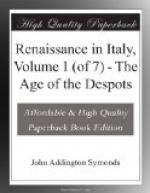CHAPTER III.
THE AGE OF THE DESPOTS.
Salient Qualities of the Fourteenth and Fifteenth Centuries in Italy—Relation of Italy to the Empire and to the Church—The Illegitimate Title of Italian Potentates—The Free Emergence of Personality—Frederick II. and the Influence of his Example—Ezzelino da Romano—Six Sorts of Italian Despots—Feudal Seigneurs—Vicars of the Empire—Captains of the People—Condottieri—Nephews and Sons of Popes—Eminent Burghers—Italian Incapacity for Self-Government in Commonwealths—Forcible Tenure of Power encouraged Personal Ability—The Condition of the Despot’s Life—Instances of Domestic Crime in the Ruling Houses—Macaulay’s Description of the Italian Tyrant— Savonarola’s and Matteo Villani’s Description of a Tyrant—The Absorption of Smaller by Greater Tyrannies in the Fourteenth Century—History of the Visconti—Francesco Sforza—The Part played in Italian Politics by Military Leaders—Mercenary Warfare—Alberico da Barbiano, Braccio da Montone, Sforza Attendolo—History of the Sforza Dynasty—The Murder of Galeazzo Maria Sforza—The Ethics of Tyrannicide in Italy—Relation of the Despots to Arts and Letters—Sigismondo Pandolfo Malatesta—Duke Federigo of Urbino—The School of Vittorino and the Court of Urbino—The Cortegiano of Castiglione—The Ideals of the Italian Courtier and the Modern Gentleman—General Retrospect.
The fourteenth and fifteenth centuries may be called the Age of the Despots in Italian history, as the twelfth and thirteenth are the Age of the Free Burghs, and as the sixteenth and seventeenth are the Age of Foreign Enslavement. It was during the age of the Despots that the conditions of the Renaissance were evolved, and that the Renaissance itself assumed a definite character in Italy. Under tyrannies, in the midst of intrigues, wars, and revolutions, the peculiar individuality of the Italians obtained its ultimate development. This individuality, as remarkable for salient genius and diffused talent as for self-conscious and deliberate vice, determined the qualities of the Renaissance and affected by example the whole of Europe. Italy led the way in the education of the Western races, and was the first to realize the type of modern as distinguished from classical and mediaeval life.




